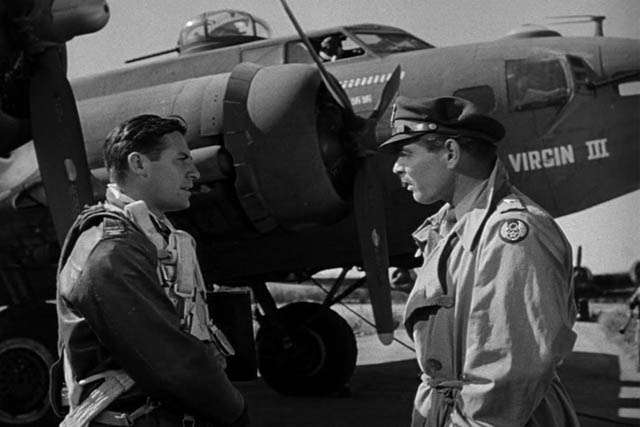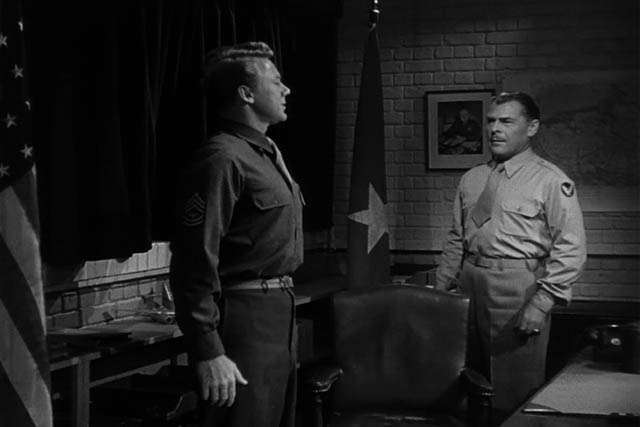| Title | Command Decision |
| Studio | MGM |
| Date Released | December 23, 1948 |
| Director | Sam Wood |
| Actors | Clark Gable, Walter Pidgeon, Van Johnson, Brian Donlevy |
| B-17 Film Guys | Mostly AAF combat footage; Paul Mantz B-17s |
| B-17 Filming Locations | Mostly 8th AF Combat footage; Van Nuys, CA |
B-17s Utilized
B-17G 44-83842
B-17F 42-3360
The Movie...
This movie has often been considered an 'also-ran' to the better known 12 O'Clock High and they both cover roughly the same territory: the angst of commanding generals in trying to get a difficult job done at the daily loss of combat crews while doing that job. Here, it's Clark Gable turning in a fine performance as Brigadier Gen. K.C. Dennis in charge of an air division, supported by a strong cast of excellent actors and well written roles. Don't look for romance here; there's not a girl to be seen anywhere, literally, and it's a bit short of action for a war film. However, it is a study on the politics of war and takes the larger view of the struggle between reality and perception.
The story revolves around Gen. Dennis and his determination to launch a series of strikes against manufacturing plants building a new German jet fighter, the "Lantze-Wolf 1" which, it turns out, bears a remarkable resemblence to the Me-262. The new jet fighter poses a great risk for the future of the war in Europe, giving the Germans the opportunity to reclaim aerial superiority over the entire continent and cease the daylight bombing raids. Dennis has been left in charge while his boss, Maj. Gen. Roland Kane (played by Walter Pidgeon) is in the U.S. trying to make the case for the 8th Air Force to continue daylight bombing. He returns to find Dennis having ordered the start of the series of raids, the first two of which prove to be extrememly costly in bomber losses. It's then discovered that the second raid hit the wrong target altogether. At the same time a Congressional committee arrives to investigate how daylight bombing is working, and Gen. Kane presses for attacks on softer targets to cut down on losses. Dennis knows the future of the war is at stake and he orders another strike on the target missed earlier. The bomber groups again lose over fifty bombers but the target is destroyed. Nonetheless, the congressmen are shocked at the losses and demand that such attacks cease if the losses are going to be so heavy. Dennis presses hard to make the raid on the third and final jet fighter target, but is relieved of his command instead. His replacement, an old friend who has to quickly find his priorities, goes ahead and schedules the raid on the difficult target, putting his own career on the line. There's more to it than that, of course, what with all the speeches and dialog and stuff like that, but that's the gist of it.
The movie was adapted from the 1947 stage production of the same name, which in itself was adapted from the 1947 book by William Wister Haines, himself a famous novelist perhaps better known for his first book, the 1934 novel Slim. Haines had served as an AAF officer during the war, and he wrote Command Decision from personal knowledge and some of his observations while serving. Production for the movie got underway in April 1948 and concluded in July, three months later. Most of it was filmed on the MGM sound stages at Culver City, California. After the editing process, it held its U.S. premiere in December of the same year, and predated the release of 12 O'Clock High by exactly one year.
But, for the B-17 aficiandos, and you wouldn't be reading this if you weren't, Command Decision borrows heavily from the wartime documentary Target for Today to provide B-17 combat footage. And there is a fair amount included, including some stunning scenes shown during the opening credits. Also, there is a long sequence showing B-17s being readied for a mission (and one lonely standout B-24) through engine starts, taxiing, and takeoff. Good stuff, particularly when viewed from the DVD.
There was one scene shot specifically for the film that required the use of two B-17s. Reports have these to be two Paul Mantz B-17s, his B-17F (42-3360) and a B-17G that is thought to be 44-83842. The short scene utilizes the B-17G in the foreground and shows both through the engine starts, and was reportedly filmed at what was then the San Fernando Valley Airport, Today, that is the Van Nuys Municipal Airport and is located fifteen or so miles north of Los Angeles. The B-17G is painted as Impatient Virgin III and carries the fictional serial number of "38362". The B-17G has a full complement of turrets (except chin turret) and has all the guns mounted, so there was some effort made toward realism. It wears what appears to be (in black and white) olive drab and gray paint, well worn, though it could be a water-soluble paint and studio aging.
The fact that two B-17s were used where one would have done is also interesting. Sources indicate that the second B-17 was B-17G 44-83842, made available by the Charles Babb Co. based at nearby Grand Central Air Terminal. Its appearance in Command Decision followed shortly an appearance in Fighter Squadron that was also filmed at Van Nuys.
Anecdotal
- The following is a short history of 44-83842, most likely the B-17 seen in the foreground of the brief scene in the movie: it was sold as surplus out of Altus AAF in May 1947 to Bob Sturges (dba Columbia Airmotive) of Troutdale, Oregon, and registered as NL1212N. In February 1948 he sold it to aircraft broker Charles Babb operating from the Grand Central Air Terminal in Southern California. Babb leased it to Warner Brothers for Fighter Squadron in the spring of 1948 and then to MGM for Command Decision. The airplane retained the gun turrets at this time. In September 1948, 44-83842 was legally sold and exported to the Dominican Republic and assigned to the nation's air force. Dan Hagedorn's excellent Central American and Caribbean Air Forces notes the arrival of a B-17G in the Dominican Republic in mid-September 1948. Two sources suggest this B-17G later carried the Dominican air force serial of FAD 2301. It remained in service until at least July 1954 but its ultimate fate is unknown.
(I have corrected earlier suggestions that this B-17G was first illegally exported for use by the Israeili Defense Forces in the 1948 war for independence.)
- The B-17 seen in the background of the brief airfielld scene was B-17F 42-3360. It was one of 475 aircraft obtained by Paul Mantz in February 1946, and the only B-17 of the 78 he obtained that survived into the 1950s. It apparently was operated for five years as an unregistered airplane, though it is thought that it only appeared in 1948's Command Decision and maybe Fighter Squadron of the same year and definitely the 1950 Chain Lightning. Shortly after the last film, it was registered as N67974 and then sold it to B-17 guy Owen F. Williams who exported it to Bolivia. It crashed at La Paz, Bolivia, on September 21, 1955.
Buy this Movie!
Links
Acknowledgements
- "When Hollywood Ruled the Skies" by Bruce W. Orriss
- Malcolm Gougon's unpublished Fortress Survivors


The only scene that actually used B-17s during the filming was shot, reportedly, at what was then the San Fernando Valley Airport, now known as Van Nuys. Two B-17s were used, and these series of photos would suggest the nearest airplane is a B-17G and the one in the background is a B-17F. Other sources have suggested the B-17G was 44-83542 and the B-17F was Mantz's 42-3360.

A wide view of the above scene as it was about to be filmed.

Actor John Hodiak, playing Lt. Col. Edward Martin, waves to Gen. Dennis as he's about to board his B-17G. Col. Martin brings to mind the character "Dead Meat" from the later film Hot Shots as his fate is sealed by the plot. Note the ficticious B-17 tail serial. It is thought that this airplane was operated as N1212N during this time, though this has not be confirmed by any records.

It is probable that the Impatient Virgin III was B-17G 44-83542. It so, this airplane had an interesting year in 1948. Though not recorded as such, it was apparently under the control of Paul Mantz in the first half of the year, appearing in Fighter Squadron with scenes shot at Van Nuys in the spring of 1948. It then appeared in Command Decision in May 1948, also at Van Nuys. In September 1948 it was exported to the Dominican Republic and assigned to that nation's air force. Its ultimate fate is unknown, but it was probably scrapped in the early 1960s.

It's easy to tell what actor Van Johnson is thinking during the filming of this scene: "Man, I'm glad I got the long tie. He looks like a doofus."

A video capture from the film showing the famous Hell's Angels as excerpted from the wartime documentary Target for Today. There are some dramatic operational scenes of B-17s borrowed from the earlier film.

Another excerpt from Target For Today as seen in Command Decision.

We are working hard to identify this airplane used in the film. No luck so far.